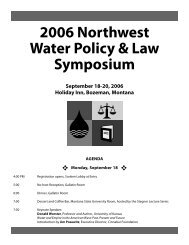aquaculturehealth - Montana Water Center - Montana State University
aquaculturehealth - Montana Water Center - Montana State University
aquaculturehealth - Montana Water Center - Montana State University
Create successful ePaper yourself
Turn your PDF publications into a flip-book with our unique Google optimized e-Paper software.
C ASEBOOK<br />
PERSPECTIVES ON KOI HERPES<br />
VIRUS IN US ORNAMENTALS<br />
BY DR ERIK JOHNSON (JOHNSON VET SERVICES, GEORGIA, USA)<br />
TAKING A BLOOD SAMPLE<br />
FROM AN ANAESTHETISED KOI<br />
Iam a veterinarian in Georgia with a specialty in fish health. Over<br />
the years, my caseload has refined itself to one principally<br />
composed of pond fish of economic or sentimental importance.<br />
I do not treat food fish, nor do I know much about them. I have<br />
become very aware of the problems facing the ornamental<br />
hobbyist and their suppliers, but I am grateful that those of us<br />
treating pet fish are not hamstrung by some of the limitations<br />
facing the food fish industry.<br />
I’m sure that the food fish veterinarian is sometimes jealous of<br />
the liberty we have in terms of medications for our ornamental<br />
patients. But still there must surely be jealousy the other direction,<br />
in that for the food fish practitioner, it’s “okay” to lose a few fish,<br />
because few specimens of trout or salmon are formally named, and<br />
sacrifices for a diagnosis can be easily made.<br />
In the private practice of ornamental fish health, sometimes the<br />
fish you want to sacrifice for a diagnosis is “the” fish they<br />
specifically want you to save. So there are advantages and<br />
disadvantages of practicing either food fish medicine or<br />
ornamental fish medicine. There are trade offs.<br />
Since I do not practice food fish medicine, I wanted to write a<br />
document that informed and entertained on specific issues<br />
developing in my area of experience. I will therefore mention some<br />
pertinent issues to let you know what’s going on in that “other<br />
world” of fish health.<br />
I want to discuss koi herpes virus (hereafter referred to as KHV)<br />
in the first of this series of articles. I hope you find my<br />
interpretations and thoughts enlightening, informative and helpful.<br />
HISTORY OF KHV<br />
KHV was first described as early as 1996 in Japan. Researchers<br />
identified it as a Corona virus and it was a serious but narrowly<br />
experienced event, killing a lot of a few fish groups, and then<br />
seemingly disappearing. It showed up again in a group of Japanese<br />
fish being held in England.<br />
The fish were being moved en masse to Israel, because it was<br />
unknown whether some as yet undetected intoxication or water<br />
quality issue was causing their rather rapid demise.<br />
The fish went to Israel, where they contaminated (and killed) a<br />
formidable amount of fish on a koi farming kibbutz. Israeli<br />
researchers were forthright and published mightily on the virus,<br />
A KOI INFECTED WITH KHV<br />
and the preponderance of information we have on the koi herpes<br />
virus comes from the original work done in Israel - and so the<br />
virus is erroneously referred to as an Israeli phenomenon.<br />
WHAT IS IT<br />
KHV is a herpes virus that features very high morbidity and nearly<br />
100 percent mortality. The virus is spread to vulnerable fish under<br />
stress, usually cohabited in confined facilities. Crowding and comorbidity<br />
with Costa or other pathogens seems to increase its<br />
virulence. The KHV virus has certain temperature-related<br />
“windows” of opportunity or action that have been instrumental<br />
in its occurrence and control.<br />
I have been professionally involved in countless cases in North<br />
America, and most of them feature the same sorts of hallmarks:<br />
• introducing and mixing of new fish without quarantine<br />
• fish have come from cold water, usually under 70˚F, and<br />
• fish have been transported and have Costia co-morbidity.<br />
Most fish are of Asian origin. However, I have seen few cases<br />
from Japan. From personal experience it seems that the incidence<br />
in Taiwan, Malaysia and China is ten-fold higher.<br />
Many cases were confounded as far as their recognition,<br />
because the fish came from spring-fed, cool ponds and were only<br />
18 AQUACULTURE HEALTH INTERNATIONAL FEBRUARY 2006






